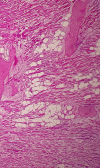Autopsy Findings and Inflammatory Markers in SARS-CoV-2: A Single-Center Experience
- PMID: 36597439
- PMCID: PMC9805743
- DOI: 10.2147/IJGM.S389300
Autopsy Findings and Inflammatory Markers in SARS-CoV-2: A Single-Center Experience
Abstract
Purpose: The systemic inflammatory response related to COVID-19 can be easily investigated in living patients. Unfortunately, not every biomarker is suitable for postmortem analysis since several factors may interfere. The aim of this study was to summarize key histopathological findings within each organ system due to COVID-19 and to assess if serological inexpensive and widely available biomarkers such as CRP, IL-6, fibrinogen and d-Dimers, associated with adverse outcomes in COVID-19, can be implemented in a post-mortem assessment.
Patients and methods: A total of 60 subjects divided in 2 groups were included. All subjects died outside a hospital setting and therefore did not receive specific or symptomatic therapies that could have modulated the inflammatory response. The first group included 45 subjects in which mandatory autopsy was performed in order to establish the cause of death and macroscopic examination of the lungs was highly suggestive of SARS-CoV-2 infection. As controls (Group 2), 20 subjects who died from polytrauma in high velocity car accidents and suicide were selected. Bronchial fluids collected during the autopsy procedure were used for the RT-PCR diagnosis of SARS-CoV-2 and serum samples were sent for analysis of IL-6, CRP, d-Dimers and fibrinogen.
Results: Compared with the control group, the subjects of the COVID-19 group were older (59±19.5 vs.38±19.15 years, p=0.0002) and had more underlying comorbidities such as hypertension (60% vs 35%, p=0.06) or were overweight (53.3% vs 30%, p=0.08). The levels of CRP, IL-6, fibrinogen and d-Dimers in postmortem plasma samples were significantly higher in COVID-19 subjects than in control group (p< 0.0001). Moreover, the level of IL-6 was significantly higher in overweight patients (r=0.52, P<0.001). In all COVID-19 subjects, the histological examination revealed features corresponding to the exudative and/or proliferative phases of diffuse alveolar damage. Large pulmonary emboli were observed in 7 cases. Gross cardiac enlargement with left ventricular hypertrophy was observed in 19 cases. The most frequent pathological finding of the central nervous system was acute/early-subacute infarction.
Conclusion: Due to the complexity of the inflammatory response, we postulate that a combination of biomarkers, rather than a single laboratory parameter, might be more effective in obtaining a reliable postmortem COVID-19 diagnosis.
Keywords: C reactive protein; COVID-19; diffuse alveolar damage; interleukin-6; postmortem.
© 2022 Cut et al.
Conflict of interest statement
The authors report no conflicts of interest in this work.
Figures






References
-
- Enache A, Ciocan V, Muresan CO, et al. Postmortem documentation of SARS-CoV-2 in utero and postpartum transmission, through amniotic fluid, placental, and pulmonary tissue RT-PCR. Appl Sci. 2021;11(20):9505. doi:10.3390/app11209505 - DOI
-
- Cut TG, Tudoran C, Lazureanu VE, Marinescu AR, Dumache R, Tudoran M. Spontaneous pneumomediastinum, pneumothorax, pneumopericardium and subcutaneous emphysema—not so uncommon complications in patients with COVID-19 pulmonary infection—a series of cases. JCM. 2021;10(7):1346. doi:10.3390/jcm10071346 - DOI - PMC - PubMed
LinkOut - more resources
Full Text Sources
Research Materials
Miscellaneous

